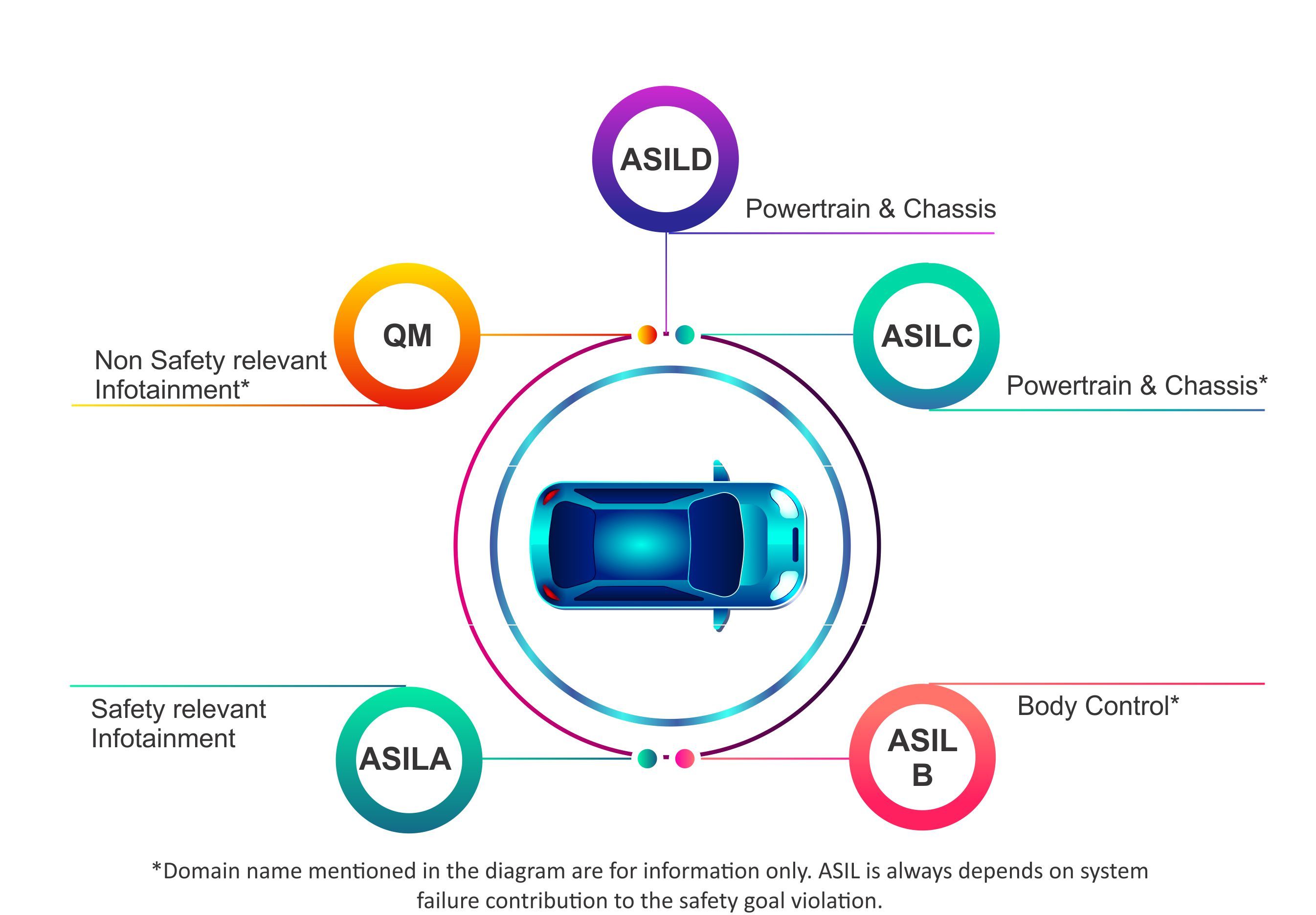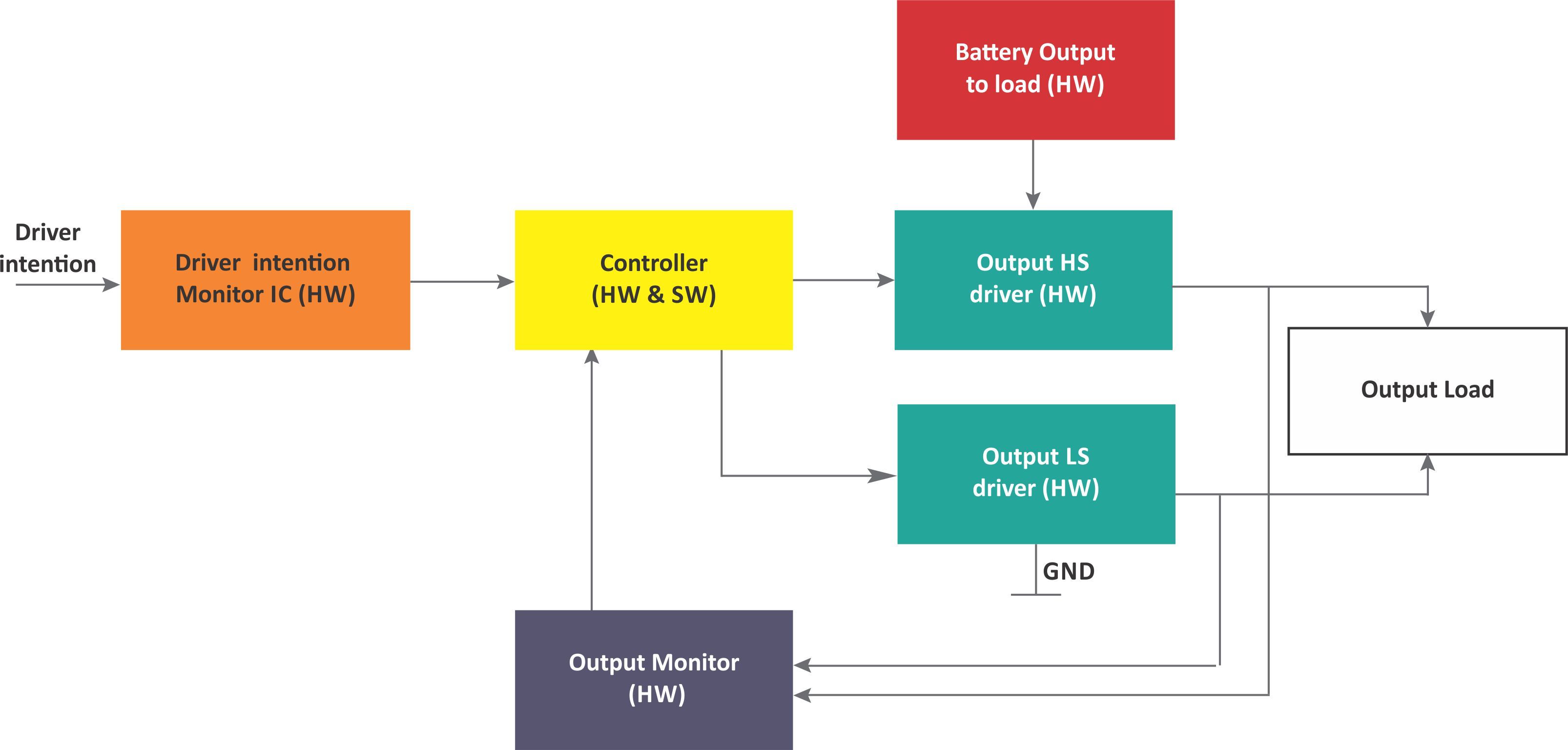Automotive Functional Safety
Automotive Functional Safety
Functional safety is important for safety critical applications in any industry where active monitoring is required on safety critical operations. The active monitors either prevents or mitigates the failure that causes safety goal violations of the system. As the number of electronic systems growing in vehicle, active functional safety become real with international functional safety standards e.g. ISO 26262 for cars and IOS 25119 for Tractors. Automotive systems developed to a Functional safety standard gives high importance to safety of driver and pedestrians, the safety standards Increases safety and Reduces vehicle call backs.
Error in a Hardware/Software results into a Fault. A fault or group faults in a system results into a Failure which may trigger Hazard. Depends on the Hazard′s severity, there will be risk to system safety. The below diagram explains the relationship between Error, Fault, Failure, Hazard and Risk.


Failures in a system are two types a) Systematic failures b) Random hardware failures. The below diagram explains failures classification
Systematic failures are development errors which are deterministic, risks due to systematic failures can be prevented by developing Hardware and Software to correct design standard (guidelines) and perform safety analysis and system verification. Risks due to Random hardware failures can be reduced by deploying correct active safety mechanism (e.g. Built in tests) into system (item).
The main objective of the functional safety is to reduce unacceptable hazard′s risk probability to acceptable level .For this, functional safety standards provide methods and guidelines for all the phases and activities in system life cycle (Inception, Safety goal identification, Requirements specification, Hardware design, Software design, Safety analysis, verification, Installation, service and Maintenance).
- ISO 26262
- Safety analysis in ISO 26262
- Confirmation measures in ISO 26262
- Functional Safety Standards
- ALTEN Global Technologies Services
ISO 26262
SO 26262 is an international functional safety standard for developing safety critical applications for electrical and/or electronic (E/E) systems that are installed in passenger cars. ISO 26262 provides automotive safety lifecycle (management, development, production, operation, service, decommissioning) guideline that helps in achieve functional safety.
ASIL
Automotive safety integrity level (ASIL) defines the acceptable failure rate of the system. There are four ASILs (ASIL-D(Highest), ASIL-C, ASIL-B, ASIL-A(Lowest)) in ISO 26262.
| ASIL | Acceptable probability of failure per operational hours |
|---|---|
| D | 10-8 |
| C | 10-7 |
| B | 10-7 |
| A | NA |
The ASIL is derived based on system's hazards severity (i.e. effect on driver, passenger, pedestrians), probability of exposure (i.e. occurrence) and controllability (possible control by driver or other passengers at risk).
Systems fall in QM category don't have to comply with any specific objectives in ISO 26262 because the risks associated with the system are acceptable for safety. The QM systems just need to follow quality management process.

Item definition
Item definition holds functional requirements, non-functional requirements, environmental requirements, operating scenarios, failure modes and interfacing requirements of the item.
Item definition is an important artifact that needs to be prepared by OEM/Tier1 which holds information that helps in identify hazard events of system and derive ASIL for the same.

Safety Goal
Safety goal is an unacceptable risk from possible hazard event.
E.g. Un intended acceleration, Un intended direction, Unintended deactivation low beamSafety goal needs to be derived for all unacceptable risks, along with this safety goal attributes (Safe state, Fault tolerance time interval, Warning incase system can't enter safe state within the expected interval) needs to be derived.
Functional Safety Concept
The functional safety concept (FSC) deploys safety mechanism that prevents the violation of safety goal. The following safety mechanisms are used in the functional safety concept:
E.g. Feedback from the previous output cycle helps the intended function to control output drive in current cycle
Technical safety concept
Technical safety concept (TSC) is derived from the functional safety concept by allocating technical safety requirements to Hardware and Software elements. E.g.

Functional Safety analysis in ISO 26262
Failures are two types (Systematic failures and Random hardware failures). Systematic failures are deterministic which comes due to problems in design, so design failure mode effect analysis helps in eliminate design failures in the system, whereas Random hardware failures are non-deterministic, so Hardware FMEDA analysis helps in add additional safety mechanisms that improve controllability of the failure.
ISO 26262 recommends the following safety analysis:
Code mutation: inject additional code statements or modify existing software component for the following:
Fault injecting testing in ISO 26262
ISO 26262 highly recommends fault injection testing for safety critical application. As part of fault injecting testing, tester injects faults into a component and test the fault prevention, detection and mitigation mechanisms are implemented correctly.
The following fault injection techniques can be used:
Code mutation: inject additional code statements or modify existing software component for the following:
Analyse error propagation to other components and its effect on safety. Additional test cases can be added if mutant is not handled by existing test case(s).
Tool qualification in ISO 26262:
Tool qualification in ISO 26262 is mandatory for higher ASIL systems if a tool fall in Tool confidence level 2 and 3. The Tool confidence level is derived based on Tool impact on detection of malfunctions in software and Tool detection level.
Tool Impact (TI):
Tool error Detection (TD):
Tool Confidence level:

Example 1: Compiler and Linker used in generate target executable must be qualified because there is possibility the compiler may add unintended additional code in target executable.
Example 2: Tool used in testing must be qualified because there is possibility the tool may fail to detect an error in the software.
Once a tool is qualified to a highest ASIL by an authority, the tool can be used in any future project without additional qualification. However, it is good practice to produce tool evaluation report for the project and find out if there are any additional tool operational requirements to be re-qualified on the tool.
Safety validation in ISO 26262
Safety validation checks safety goals and functional safety concept are correct, complete and fit for functional safety of the item under development. Safety validation can be done through testing (Similar to vehicle level testing), analysis (FMEA, FTA, ETA, simulation) and reviews.
Key features of ALTEN Global Technologies developed telematic gateway ECU:
Key features of ALTEN Global Technologies Vehicle tracking ECU:
Key features of ALTEN Global Technologies Fleet management system (Mobile and Web application):
Functional Safety analysis in ISO 26262
Failures are two types (Systematic failures and Random hardware failures). Systematic failures are deterministic which comes due to problems in design, so design failure mode effect analysis helps in eliminate design failures in the system, whereas Random hardware failures are non-deterministic, so Hardware FMEDA analysis helps in add additional safety mechanisms that improve controllability of the failure.
ISO 26262 recommends the following safety analysis:
Confirmation measures in ISO 26262
Confirmation measures is an important activity that ensures project work products compliance to ISO 26262 objectives. The following confirmation measures are requirements from ISO 26262:
| Confirmation Measures | Objective | Work product | Remarks |
|---|---|---|---|
| Confirmation review | Evaluates project work products compliance to ISO 26262 requirements i.e. checking of correctness with respect to formality, contents, adequacy and completeness regarding the requirements of ISO 26262. | Confirmation review report | Selective work products (as per ISO 26262)undergo confirmation review. ASIL A, B, C, D |
| Functional Safety Audit | Evaluates item implementation process is in accordance with process specified in Safety plan | Functional safety audit report | ASIL (B), C, D |
| Functional Safety Audit |
Evaluates item functional safety achieved as specified in item definition , checks the following:
|
Functional safety assessment report | Confirmation reviews and Functional safety audits can be combined with Functional safety assessment report. ASIL (B), C, D |
Safety case in ISO 26262
Safety case is a work product in ISO 26262, it contains list of work products produced in safety lifecycle. The safety case is a running document which needs to be produced for confirmation review, once the confirmation review accepted the final safety case it needs to be submitted to Functional safety assessment.
Stake holders' responsibilities in achieving ISO 26262 functional safety compliance
All the stakeholders of the system must perform their activities to achieve ISO 26262 functional safety. ISO 2626 Part2 activities (Safety plan, Safety culture, DIA and Safety case‥ etc) are all three stakeholders (OEM, Tier1 and Tier2) responsibility. ISO Part 3 activities (Item definition, Safety goals, derive ASIL, Hazard analysis and risk assessment. Etc) are OEM's responsibility. ISO Part 4 activities (System design, Technical safety concept, System testing‥ etc) are Tier1's responsibility. ISO Part 5 and 6 activities (Hardware and Software safety requirements, HW and SW design, verification‥ etc) are Tier2's responsibility. ISO 26262 Part9 activities (System design FMEA, Hardware FMEDA, Software design FMEA and Software dependent failure analysis) are Tier1 and Tier2 responsibility.
Automotive functional safety standards
Avionics domain functional safety standards:
Automotive domain functional safety standards:
ISO 26262: This standard provides guideline for management, development, verification, production and service of electrical and/or electronic (E/E) systems within road vehicles. ISO 25119 :This standard provides guideline for design and verification of electrical and/or electronic (E/E) systems in Tractors in agriculture and forestry.
The below diagram explains the relation between the standards:

ALTEN Global Technologies Services in Automotive Functional Safety
ALTEN Global Technologies has vast experience with functional safety in both Avionics and Automotive domains. ALTEN Global Technologies designed and developed functional safety systems and passed functional safety audits, our rich experience with safety audits has helped our customers very well.